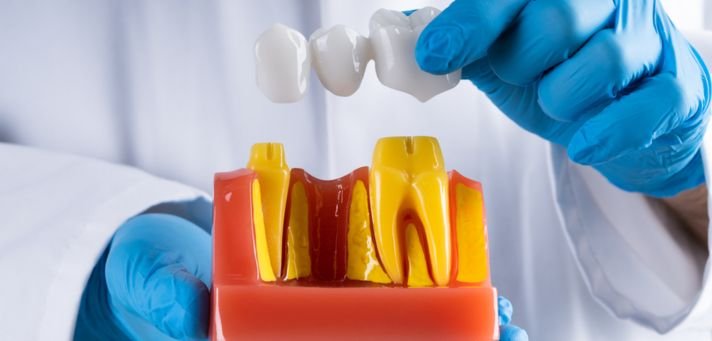Crowns/Bridges
Crowns and bridges are essential restorative dental treatments designed to restore damaged teeth and replace missing teeth, respectively. These prosthetic devices play a crucial role in restoring the function, aesthetics, and overall health of a patient’s smile.
Phone
+91 9833512034
dentarc1@gmail.com
Request a Consult
Dental Crowns
A crown, also known as a cap, is a custom-made restoration that covers the entire visible portion of a damaged tooth. Crowns are typically used to restore teeth that are severely decayed such as root canal treated tooth, fractured, or worn down. They provide strength and protection to the compromised tooth while enhancing its appearance.

Procedure Steps
1. Preparation:
A dentist prepares the damaged tooth by removing any decay and shaping it to accommodate the crown. This may involve reducing the tooth's size and building it up if necessary.
2. Impressions:
Impressions of the prepared tooth and surrounding teeth are taken to create a custom-fit crown. These impressions are sent to a dental laboratory where the crown is fabricated.
3. Temporary Crown:
While the permanent crown is being made, a temporary crown is placed over the prepared tooth to protect it and maintain function.
4. Placement:
Once the permanent crown is ready, the temporary crown is removed, and the new crown is cemented in place. A dentist ensures a proper fit and bite adjustment for optimal comfort and function.
Types of Crowns
Metal Crowns
Constructed from gold or other alloys, these crowns deliver superior durability and strength, making them ideal for molars.
Metal-free Crowns
Metal-free crowns are durable, biocompatible, and natural-looking restorations made from ceramic or zirconia, ideal for aesthetic and allergy-free dental solutions.
Examples:
1.Zirconia Crowns: Made from zirconium dioxide, they offer strength, durability, and a natural, translucent look.
2. Emax Crowns: Crafted from lithium disilicate, they provide excellent aesthetics with a lifelike appearance.
Porcelain-Fused-to-Metal Crowns
These crowns feature a metal base for strength and a porcelain overlay for natural aesthetics, offering a balanced solution for durability and appearance.
Dental Bridges
A dental bridge is a prosthesis used to replace one or more missing teeth by anchoring artificial teeth to adjacent natural teeth or dental implants. Bridges fill the gap created by missing teeth, restoring the function and appearance of the smile.

Procedure Steps
1. Preparation:
The adjacent teeth (abutment teeth) are prepared by removing a portion of their enamel to create space for the bridge. In certain cases a rootcanal is performed on the abutment teeth first, followed by a tooth preparation for the bridge.
2. Impressions:
Impressions of the prepared teeth and the missing tooth space are taken to create a custom-fit bridge. These impressions are sent to a dental laboratory for fabrication.
3. Temporary Bridge:
A temporary bridge is placed to protect the prepared teeth and maintain function while the permanent bridge is being made.
4. Placement:
Once the permanent bridge is ready, the temporary bridge is removed, and the new bridge is cemented in place. The dentist ensures a proper fit and bite adjustment for optimal comfort and function.
Types of Bridges
Traditional Bridges
Involve creating crowns for the abutment teeth with a pontic (artificial tooth) in between.
Cantilever Bridges
Used when there are adjacent teeth on only one side of the gap.
Maryland Bridges
Use a metal or porcelain framework bonded to the back of the adjacent teeth for support.
Benefits of a Crowns/Bridges
Restored Function
Crowns and bridges restore the ability to chew and speak properly.
Enhanced Aesthetics
These restorations improve the appearance of damaged or missing teeth, creating a natural-looking smile.

Improved Oral Health
By filling gaps and protecting damaged teeth, crowns and bridges prevents shifting of adjacent teeth in to the missing tooth space , occlusal imbalance and reduce the risk of further dental issues.
